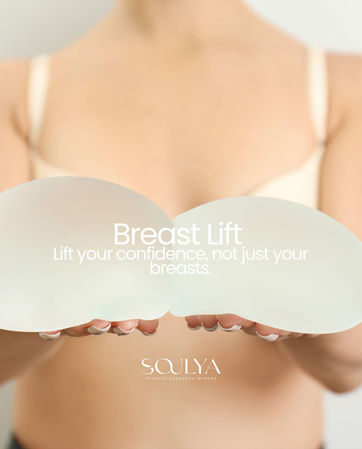Have you ever noticed that your breasts are slightly different from one another? Don’t worry! This condition is known as breast asymmetry, and it’s more common than you might think.
It’s very rare for breasts to be perfectly identical, and usually, the differences are so subtle that they’re not noticeable to the naked eye. However, there are cases where the differences are more noticeable: the size, shape, or position of the breasts may differ and cause insecurity or self-esteem issues for women.
If this sounds like you, keep reading. Today, I’m going to tell you everything you need to know about breast asymmetry: causes, types, and treatment options to correct it.
🧐 What is Breast Asymmetry?
Breast asymmetry refers to the difference in volume, shape, or position between the two breasts. Every woman is unique, and so are her breasts. Asymmetry can be a natural characteristic of the body, or the result of a health condition.
🔹 The main types of asymmetry are:
- Size and Volume Asymmetry: One breast is larger than the other, known as anisomastia.
- Areola and Nipple Asymmetry: The size, position, or shape of the areola differs between the two breasts, known as anisotella.
- Shape Asymmetry: Although the size and volume are similar, the shape of the breasts is different—one may be rounder, and the other more conical.
- Position Asymmetry: Sometimes one breast is higher or lower than the other. This can be due to tissue density or the shape of the rib cage.
🔍 Why Does Breast Asymmetry Happen?
You may be wondering, “Why does this happen?” Breast asymmetry has many causes, ranging from genetic to hormonal factors, and even lifestyle changes, which I’ll explain now:
👶 Genetic Factors
Most of the time, asymmetry is a natural characteristic of the body, which may have been inherited just like eye color or hair color. We can compare it to having one eyebrow a little higher than the other, or one eye more open than the other.
🌸 Hormonal Changes
You’ve probably noticed that your bust has changed significantly since your teenage years. Over time, breasts go through growth cycles, so it’s not uncommon for one breast to develop faster than the other during puberty. These are normal changes, but sometimes they leave permanent differences.
On the other hand, pregnancy and breastfeeding are stages where many hormonal changes occur, causing the breasts to swell and grow significantly. In many cases, the breasts return to their previous size, and the differences level out over time. However, in other cases, size and shape may be altered, causing one breast to be larger or have a different shape than the other.
During menopause, it’s also common for breasts to change due to the decrease in estrogen levels. They tend to have more fatty tissue but less glandular tissue, which may reduce their size. Additionally, changes in the areola and nipple are common.
💊 Health Conditions
Changes in the breasts can also indicate a condition that should be addressed immediately:
- Breast Cysts: When a milk duct fills with liquid, a cyst forms. Some can grow quite large or cluster in one breast, affecting its size and shape.
- Breast Hematoma: A hematoma is a blood accumulation in the tissue, similar to a very swollen bruise. It typically appears after an injury and fades over time, but if it doesn’t go away after a few days, you should get checked.
- Tumors: A tumor or abnormal tissue growth in the breast can manifest as a change in the size, shape, or contour of the breast. Tumors can be malignant (cancerous) or benign (non-cancerous).
If, in addition to asymmetry, you notice lumps, nipple roughness, or non-lactation-related discharge, you should seek immediate medical attention.
🔬 How is Breast Asymmetry Diagnosed?
In most cases, we conduct a clinical evaluation in the office. We examine the volume, shape, size, and approximate weight of each breast.
Additionally, to rule out conditions affecting your bust, I’ll likely recommend that you undergo a mammogram and ultrasound, which will help assess tissue density, as well as detect cysts or any other abnormalities.
💉What is the Treatment for Breast Asymmetry?
As a plastic surgeon, my goal is to listen to you and understand what you’re looking for, so we can create a plan that gives you natural results and makes you feel great. The treatment options for breast asymmetry are:
💉 Breast Implants: A Solution for Volume Differences
Implants are one of the most effective solutions for correcting asymmetry in breast size and shape. They are especially recommended if the difference is around 200 grams or more, to achieve a harmonious result.
🔄 Breast Lift: A Solution to Correct Position
If your breasts have suffered the effects of gravity due to breastfeeding, pregnancy, and weight fluctuations, mastopexy or a breast lift is the perfect solution. This procedure involves reshaping the breast tissue, removing excess skin, and repositioning the nipple and areola. If you want to increase size, implants can also be combined to achieve a spectacular result.
🔄 Lipofilling: Fat Transfer
If the asymmetry is minor, lipofilling is the ideal treatment. This procedure is performed using the patient’s own fat. In other words, if you undergo minor liposuction on your stomach, arms, or even neck, the fat is transferred to the smaller breast to increase its volume and achieve balance in your bust. It is important to mention that absorption is high and the result will depend on each type of patient.
💡 Are You Ready to Correct Your Breast Asymmetry?
If you feel that it’s time to make a change, the first step is for us to meet for a consultation. At Soulya, you’ll find a safe, confidential space, with a wonderful team that will make you feel comfortable as we talk about your concerns and choose the best path together so you feel great in your body.
🔹 The process is simple and safe:
- Consultation: During your first visit, we’ll examine your breasts, evaluate the degree of asymmetry, and talk about the results you expect. To help you make the best decision, I will explain the treatment options, incision techniques, and the potential results. We’ll also take time to address all your questions. Together, we’ll create a personalized plan for your needs.
- Surgery. In general, surgeries are performed under anesthesia and last approximately 2 hours. This time may increase if you choose to combine two or more surgeries: liposuction with lipotransfer, or a mastopexy with implants.
- Recovery. Recovery from breast surgery takes one month, with minimal discomfort that can be controlled with the medication I will prescribe. In addition, for the next two months, you will wear a special compression bra that will help reduce swelling and allow your breasts to settle into their ideal position. Most patients can return to their daily activities within a week and to their normal routine, including exercise, after four weeks.
⚖️ My Commitment: Your Safety and Natural Results
I truly hope this information helps you make the best decision for yourself.
As a plastic surgeon with the Soulya team, my priority is to ensure you feel safe and confident every step of the way. I’m here to answer all your questions and guide you toward the harmonious body you desire.
See you at the consultation!




